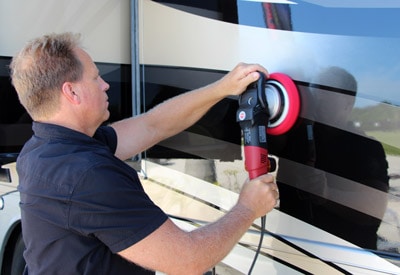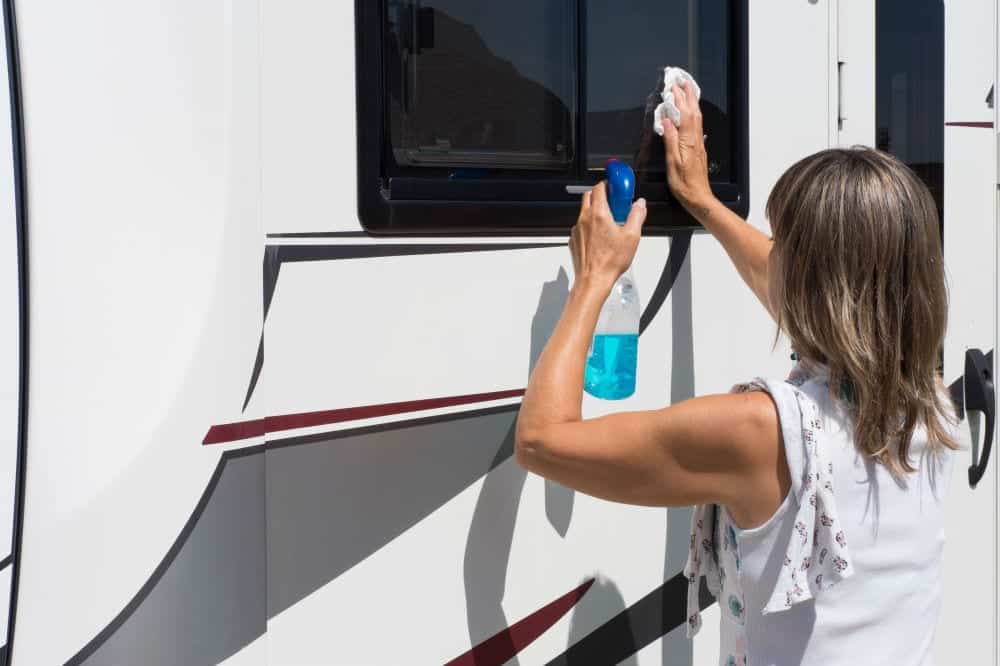Last Updated on March 24, 2022 by Ted Mosby
Don’t you want to extend the lifespan of your beloved RV? Do you want to know how to remove oxidation from your RV fiberglass? If you have answered yes, it is insisted on keeping on reading the post.
Just like your home that you want to keep clean and tidy all the time because you live there, you should also do the same with your home on wheels. After all, your RV is the place where you live when away from your home, camping at one of your favorite destinations.
However, while cleaning your RV, unlike your home, you have to be extra careful, especially if the body of your RV is constructed with fiberglass.
Since fiberglass is incredibly durable and makes sure to keep the RV lightweight, it also tends to protect your recreational vehicle when you are driving it on a bumpy road and uneven terrain.
However, probably the biggest issue that you may confront is the formation of the RV fiberglass surface.
Oxidation of RV fiberglass is a chemical reaction that shortens the lifespan of fiberglass of your recreational vehicle by producing rust, which is extremely harmful to your RV’s metals. To keep it away from your RV, you should know how to remove oxidation from RV fiberglass.
Oxidation is nothing but a fancy word for a chemical reaction of external elements, such as air, oxygen, and heat, that, when combined, produce rust.
Let’s discuss it in detail.
Removing oxidation from RV fiberglass is not that hard if you perform it properly. Below is how you can remove both mild and extreme oxidation from the RV fiberglass.
Camping Gear SALE!
We have teamed up with Ape Survival to give you a huge 25% off EVERYTHING on their store! They have camping gear, hiking gear, survival gear and much more, all at 25% off when you click the link below.
SHOP NOWHow to Remove Mild Oxidation from RV Fiberglass?
Although removing mild oxidation from the RV fiberglass is considerably easy than removing extreme oxidation, you have to put in your best effort.
You will need,
- Greasing Solution.
- Oxidation Remover.
- Polish.
- RV Wax
If you’re confronting light-to-mild oxidation, the best thing that you can use to clean the fiberglass surface of your RV is a degreasing agent. This is because when the fiberglass starts forming oxidations, the surface becomes sticky, attracting and sticking the dust quickly. This means you are going to deal with grease on your RV’s fiberglass surface.
The best way to keep your RV clean and tidy is to wash it with a degreasing agent. When removing mild oxidation from the RV, apply the degreasing agent to the fiberglass surface, and rub it gently.
If you are using the best quality degreasing, it will sit quickly; however, if you are using a low-quality degreasing solution, wait patiently to let it sit.
Once you have applied the greasing solution, start rinsing the fiberglass surface of your RV. Now, you will have to use an oxidation remover and leave it until it dries out. Now peel off, and you will see that your RV’s fiberglass is shining.
Using a polishing substance means your RV’s fiberglass surface will keep shining for an extended period. To do that, apply the polishing compound and spread it over the fiberglass surface.
I recommend you to use polish with abrasive substances to remove stains, scratches, etc. Finally, use the RV Wax to protect the fiberglass surface from external elements.
How to Remove Extreme Oxidation from Fiberglass?
As you can see, removing the mild oxidation is not an arduous task, but what to do when there is extreme oxidation on the fiberglass surface?
You cannot just apply an oxidation remover and hope it will remove oxidation from RV fiberglass. What you have to do is to apply the wet sanding, polishing, and waxing method to remove the extreme oxidation from the RV fiberglass.
Camping Gear SALE!
We have teamed up with Ape Survival to give you a huge 25% off EVERYTHING on their store! They have camping gear, hiking gear, survival gear and much more, all at 25% off when you click the link below.
SHOP NOWSo, how to remove oxidation from RV fiberglass through wet sanding?
When there is extreme oxidation on the RV’s fiberglass surface, the best way is to apply wet sanding but only if you have experience. Of course, it isn’t only a time-consuming task but also removes the top coating layers.
I strongly suggest doing it with extreme care, or else you will end up damaging the fiberglass surface if you haven’t done it before. Moreover, you should do this by DIY if you are confident.
While doing wet sanding, you will need a sandpaper sheet of 1,500 grit for extreme oxidation. Moreover, you can have either finer or coarser grit sandpaper, as it depends on the oxidation severity.
Now, be very attentive and use the coarse sandpaper with extreme care, so you don’t end up scraping the fiberglass.
Now, let’s move to how to remove oxidation from RV Fiberglass?
1. Soak the Sandpaper in Water
Your first step should be soaking the sandpaper in the water for at least a day. Do not mix any harmful chemicals in the water except automotive soap, that, however, you can use for reducing the corrosive of sandpaper. Since sandpapers wear out quickly, soak several pieces.
2. Find a Dirt-Free place to wash your RV
Secondly, you have to find a clean, dirt-free surface when wet sanding your RV before you start the wet sanding process. After that, wash your RV thoroughly using automotive soap water to remove obstructions from the fiberglass surface. Once you have washed the RV, use clean water to rinse it.
Now, you don’t necessarily need to wait until it dries out since using wet sand on wet fiberglass surfaces will produce better results.
3. Start Sanding
Thirdly, since it will not be possible for you to evenly sand using a finger, the best way is to use a sponge and wrap the sandpaper around it. Moreover, also make sure that the sandpaper lies flat on the fiberglass surface.
Now, start sanding the surface with circular motions while applying a bit of pressure. Do not apply too much force, or else you will end up damaging the RV paint.
However, if you think results aren’t as good as you want, try to increase the pressure a bit more until you see better results. When you feel that the sandpaper sheet has worn out, use another sandpaper.
4. Rinse the Fiberglass Surface
Fourthly, if you think the fiberglass surface has become smooth, it means you can now stop sanding it. Make sure you have rinsed the surface thoroughly to remove any soap or debris from the surface, as you are going to apply polish and wax on it.
Once done, leave it until it completely dries out. Moreover, keep your RV at a place where there is no direct sunlight reaching it because you haven’t applied any protective layer yet.
To dry it out quickly, you can also use a hairdryer or a towel, if possible.
5. Applying Polish
Now, once your RV is dried out completely, it’s time to apply polish on the fiberglass surface. You should buy a high-grade, good-quality polishing compound even though it will cost you a bit extra of your money.
You should follow the instructions closely written on the polish product to know how to apply it in a better way. Use a soft cloth or buffer to start applying polish.
I recommend using a buffer, although it is a bit pricey, it will get the job done for you. While using a cloth means there is a chance that it might leave an uneven finish.
6. Applying Wax
Finally, after applying the polish, now you are ready to give it a final touch by applying wax. Apply the wax on the areas to protect them from external elements, like blazing sunlight, dust, and weather elements.
Moreover, applying wax also means that it will give a better shine to your RV’s fiberglass surface.
Why Does Fiberglass Oxidation Occur?
Most RV manufacturers use fiberglass design for windows and other areas where you can have an outside view. As I have stated above that the simple reason why fiberglass is used in the majority of RV body construction is it is durable, and its longevity provides RVier extended protection against bumps and thuds on the road.
However, besides the protection that it delivers, you will have to deal with oxidation formation on the surfaces. The reason why fiberglass oxidation occurs is the external elements like pollutants, excessive moisture, heat, and sun glare that, when combined, produce the oxidation.
Moreover, to keep the oxidation at bay, a wax coating on the fiberglass surface is a good thing but not for an extended period as it also wears out over time, exposing the surface to external elements, which start forming oxidation.
Another common reason why oxidation occurs is the poor maintenance that also quickens the process of fiberglass surface to fade and rust.
How to Eliminate or Prevent Oxidation from Forming?
As I have stated earlier, the biggest culprits that quicken the process of oxidation are blazing sunlight and withering. Being a member of the RVing community, you should know how to remove the Oxidation from RV fiberglass, but it would be nice to learn how to prevent it from forming before it happens.
The primary and easiest way to keep oxidation at bay is to regularly clean your RV to fend off the rust. Wash the RV regularly to prevent oxidation. Take immediate action and never overlook the rust signs even if they are small. Once you finish cleaning, apply the RV wax each time you clean it as it will act as an extra layer of protection.
If possible, store your RV under a shaded area or find a place where sunlight doesn’t directly reach your RV. Regular maintenance and cleaning your RV means it won’t lose its charm for extended periods and also keep its longevity.
Wrapping Up
Keeping your RV clean and in its peak condition is important to extend its lifespan. This can be achieved through good maintenance and regular cleaning.
Since most of the RVs have a fiberglass-constructed body that makes them lightweight and durable, it also means that you will have to deal with fiberglass oxidation issues.
Above, I have discussed all how to remove from RV fiberglass. I’ve also discussed how you can prevent oxidation formation in the first place. Still, in case of any queries, you are always welcome to write a comment below.
FAQ
Although using the wet sand method to remove extreme oxidation from fiberglass produce much better results, you should use it only when you think no other cleaning solution will work. Moreover, it is also a time-consuming process, and before doing it, you should ask yourself whether you can do it DIY or not.Is it safe to use a wet sanding method to remove extreme oxidation from the RV fiberglass surface?
Yes, parking your RV under direct sunlight is one of the biggest reasons for oxidation on the fiberglass surface. Moreover, it also causes harm to your RV’s paint even if you have applied a protected layer to prevent damage that can be caused by external elements, such as dust, sunlight, etc.Is storing your RV under direct sunlight cause any harm?
You should never perform the wet sand method if you think the oxidation can be removed easily by washing your RV using automotive soap. The wet sanding process is only recommended for extreme oxidation.Should I apply wet sanding to remove mild oxidation from the RV fiberglass surface?
Table of Contents



